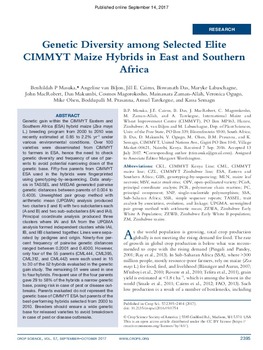Mostrar el registro sencillo del ítem
Genetic diversity among selected elite CIMMYT maize hybrids in East and Southern Africa
| Autor: | Masuka, B. |
| Autor: | van Biljon, A. |
| Autor: | Cairns, J.E. |
| Autor: | Das, B. |
| Autor: | Labuschagne, M. |
| Autor: | MacRobert, J.F. |
| Autor: | Makumbi, D. |
| Autor: | Magorokosho, C. |
| Autor: | Zaman-Allah, M. |
| Autor: | Ogugo, V. |
| Autor: | Olsen, M. |
| Autor: | Prasanna, B.M. |
| Autor: | Amsal Tesfaye Tarekegne |
| Autor: | Fentaye Kassa Semagn |
| Año: | 2017 |
| URI: | http://hdl.handle.net/10883/19200 |
| Resumen: | Genetic gain within the CIMMYT Eastern and Southern Africa (ESA) hybrid maize (Zea mays L.) breeding program from 2000 to 2010 was recently estimated at 0.85 to 2.2% yr−1 under various environmental conditions. Over 100 varieties were disseminated from CIMMYT to farmers in ESA, hence the need to check genetic diversity and frequency of use of parents to avoid potential narrowing down of the genetic base. Fifty-five parents from CIMMYT ESA used in the hybrids were fingerprinted using genotyping-by-sequencing. Data analysis in TASSEL and MEGA6 generated pairwise genetic distances between parents of 0.004 to 0.4005. Unweighted pair group method with arithmetic mean (UPGMA) analysis produced two clusters (I and II) with two subclusters each (A and B) and two sub-subclusters (IAi and IAii). Principal coordinate analysis produced three clusters where IAi and IIA from the UPGMA analysis formed independent clusters while IAii, IB, and IIB clustered together. Lines were separated by pedigree and origin. Ninety-five percent frequency of pairwise genetic distances ranged between 0.2001 and 0.4000. However, only four of the 55 parents (CML444, CML395, CML312, and CML442) were each used in 15 to 30 of the 52 hybrids evaluated in the genetic gain study. The remaining 51 were used in one to four hybrids. Frequent use of the four parents gave 29 to 58% of the hybrids a narrow genetic base, posing risk in case of pest or disease outbreaks. Parents evaluated do not represent the genetic base of CIMMYT ESA but parents of the best-performing hybrids selected from 2000 to 2010. Breeders should ensure a wide genetic base for released varieties to avoid breakdown in case of pest or disease outbreaks. |
| Formato: | |
| Lenguaje: | English |
| Editor: | Crop Science Society of America |
| Copyright: | CIMMYT manages Intellectual Assets as International Public Goods. The user is free to download, print, store and share this work. In case you want to translate or create any other derivative work and share or distribute such translation/derivative work, please contact CIMMYT-Knowledge-Center@cgiar.org indicating the work you want to use and the kind of use you intend; CIMMYT will contact you with the suitable license for that purpose. |
| Tipo: | Article |
| Región: | South and East Africa |
| Lugar de publicación: | Madison, WI |
| Páginas: | 2395-2404 |
| Número: | 5 |
| Volumen: | 57 |
| DOI: | 10.2135/cropsci2016.09.0754 |
| País: | SOUTHERN AFRICA |
| País: | EASTERN AFRICA |
| Agrovoc: | MAIZE |
| Agrovoc: | GERMPLASM |
| Agrovoc: | GENETIC VARIATION |
| Revista: | Crop Science |
Ficheros en el ítem
Este ítem aparece en la(s) siguiente(s) colección(ones)
-
Maize
Maize breeding, phytopathology, entomology, physiology, quality, and biotech

